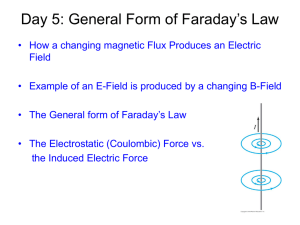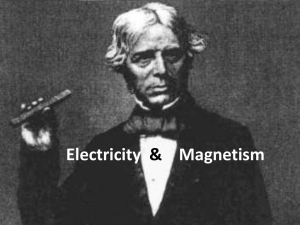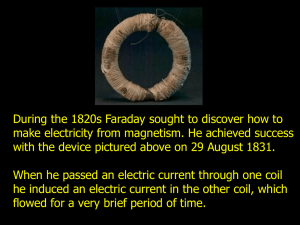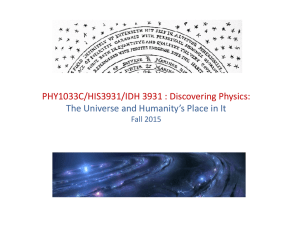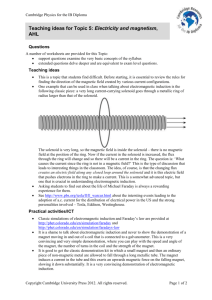Document 10343649
advertisement
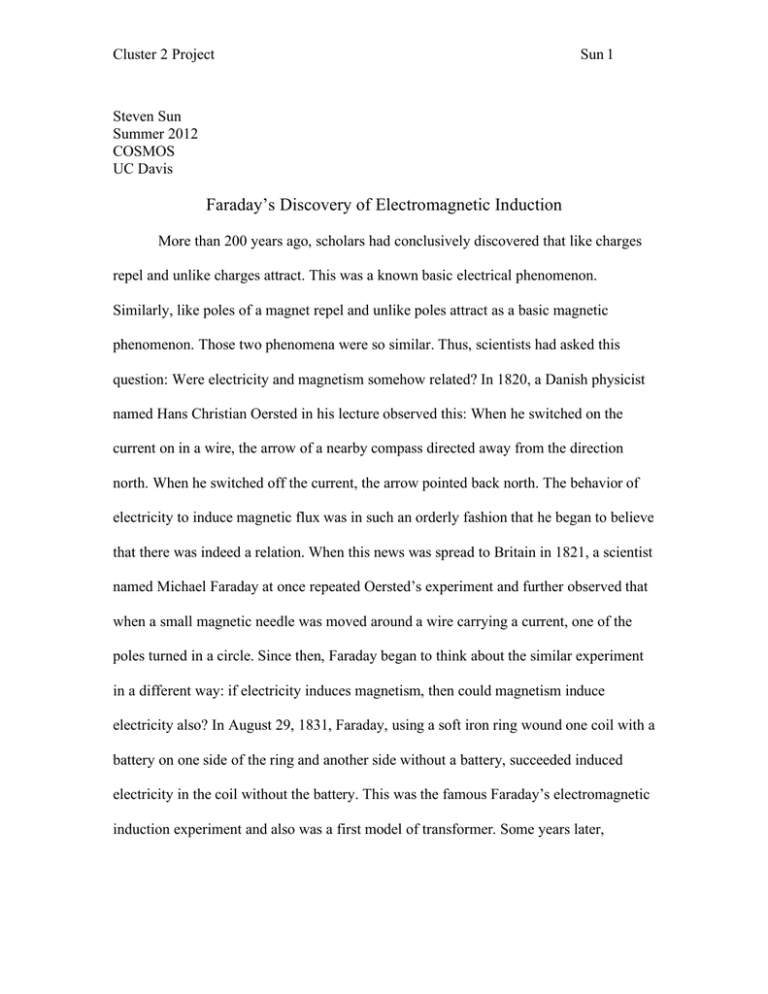
Cluster 2 Project Sun 1 Steven Sun Summer 2012 COSMOS UC Davis Faraday’s Discovery of Electromagnetic Induction More than 200 years ago, scholars had conclusively discovered that like charges repel and unlike charges attract. This was a known basic electrical phenomenon. Similarly, like poles of a magnet repel and unlike poles attract as a basic magnetic phenomenon. Those two phenomena were so similar. Thus, scientists had asked this question: Were electricity and magnetism somehow related? In 1820, a Danish physicist named Hans Christian Oersted in his lecture observed this: When he switched on the current on in a wire, the arrow of a nearby compass directed away from the direction north. When he switched off the current, the arrow pointed back north. The behavior of electricity to induce magnetic flux was in such an orderly fashion that he began to believe that there was indeed a relation. When this news was spread to Britain in 1821, a scientist named Michael Faraday at once repeated Oersted’s experiment and further observed that when a small magnetic needle was moved around a wire carrying a current, one of the poles turned in a circle. Since then, Faraday began to think about the similar experiment in a different way: if electricity induces magnetism, then could magnetism induce electricity also? In August 29, 1831, Faraday, using a soft iron ring wound one coil with a battery on one side of the ring and another side without a battery, succeeded induced electricity in the coil without the battery. This was the famous Faraday’s electromagnetic induction experiment and also was a first model of transformer. Some years later, Cluster 2 Project Sun 2 Maxwell formulated Faraday’s electromagnetic induction experiment into an equation, called Faraday’s law: Diagram and Original Faraday’s Notes Cluster 2 Project Sun 3 Outline of Presentation 1. Historical context: ( 1-2 minutes:) More than 200 years ago, scholars had conclusively discovered that like charges repel and unlike charges attract. This was a known basic electrical phenomenon. Similarly, like poles of a magnet repel and unlike poles attract as a basic magnetic phenomenon. Thus, scientists had asked this question: Are electricity and magnetism somehow related? In 1820, a Danish physicist named Hans Christian Oersted in his lecture observed the following phenomenon: When he switched on the current in a wire, the arrow of a nearby compass directed away from the direction north. When he switched off the current, the arrow pointed back north. The behavior of electricity to induce magnetic flux was in such an orderly fashion that he began to believe that there was indeed a relation. 2. The problem: (1-2 minute) When this news was spread to British in 1821, a scientist named Michael Faraday at once repeated Oersted’s experiment and further observed that when a small magnetic needle was moved around a wire carrying a current, one of the poles turned in a circle. Since then, Faraday began to think about this problem in a different way: if electricity induces magnetism, then could magnetism induce electricity also? 3. Solution to the problem (3-4 minutes): Eleven years later, on August 29, 1931, Faraday wound a copper wire on one side of a soft iron ring (called A side by Faraday) and a copper wire on the other side of the ring (called B side). He made B side wire pass a distance about 3 feet long from the ring and placed a magnetic needle near the wire. Then he connected the ends of the wire on A side to a battery. Immediately he observed the movement of the needle. He also observed that “On breaking the connection of A side with Battery again a disturbance of the needle.” (Faraday’s notebooks) Finally, Faraday induced magnetism in the wire and soft iron core from a changing electric current, and the magnetism from the wire and core influenced the magnetic needle. This is the very first Faraday’s electromagnetic induction experiment and also the very first model of a so-called transformer nowadays. Cluster 2 Project Sun 4 4. Relate theory: (3-4 minutes): To account for his first and more other induction experiments, Faraday imagined that a current could create magnetic “lines of force” (now so-called lines of magnetic field). Faraday thought that his “lines of force” were carried by ether in space (of course, Michelson-Morley experiment disproved the existence of ether). When those magnetic “lines of force” changed as a function of time, then electric “lines of force” (so-called lines of electric field now) were created in space. Maxwell formulated Faraday’s theory into a mathematical equation as: represents total magnetic field lines through a surface (called magnetic flux). As long as the magnetic flux changes as a function of time, non-electrostatic electric field E will be created in space and a closed line integral of the E is not zero but equal to the magnitude of the rate of instantaneous change of the total magnetic flux as a function of time. The negative sign here represents the direction of the non-electrostatic electric field is always opposite to the changes of the magnetic flux (so called Lenz’s law). Cluster 2 Project Sun 5 My Notes • Faraday (1791-1867) was “the son of a blacksmith who could do little more than provide the basic necessities of life to his wife aid many children. At the age of 14 Michael left school and was apprenticed to a good natured bookbinder who encouraged him to read the books he was binding. He attended some of Sir Humphrey Davy's lectures at the Royal Institution, and by a fortunate chance managed in 1813 to obtain a position as Davy's assistant. He was so successful in the research that he did there that only twelve years later he succeeded Davy as Director of the Royal Institution laboratories.” • In 1820, a Danish physicist named Hans Christian Oersted in his lecture observed this: When he switched on the current on in a wire, the arrow of a nearby compass directed away from the direction north. When he switched off the current, the arrow pointed back north. • 1821, a scientist named Michael Faraday at once repeated Oersted’s experiment and further observed that when a small magnetic needle was moved around a wire carrying a current, one of the poles turned in a circle. • “In 1821 Faraday attached a magnet upright to the bottom of a deep basin, and then filled the basin with mercury so that only the pole of the magnet was above the surface. A wire free to move was attached above the bowl and dipped into the mercury. When Faraday passed a current through the wire and the magnet, the wire continuously rotated around the magnet. In an adaptation of the experiment, he made the magnet rotate around the wire. The great significance of these simple Cluster 2 Project Sun 6 demonstrations is that electrical energy was being converted into mechanical energy for the first time.” • “In 1831 Faraday learned of the experiments of Joseph Henry (1797-1878) in Albany, New York. The first electromagnet had been created in 1823 by the English physicist William Sturgeon (1753-1850), and Henry improved the technique greatly, observing that the polarity could be reversed by a reversal of the direction of the - current. This led Faraday to his famous experiment of 1831 in which he demonstrated electromagnetic induction.” • In physics, a quantitative relationship between a changing magnetic field and a changing electric field developed on the basis of experimental observations made in 1831 by the British scientist Michael Faraday. • Faraday discovered that whenever the magnetic field about an electromagnet was made to grow and collapse by closing and opening the electric circuit of which it was a part, an electric current could be detected in a separate conductor nearby. • Moving a magnet rod in and out of a coil of wire also induced a current in the wire. Moving a conductor near a stationary permanent magnet caused a current to flow in the wire, too, as long as it was moving. • Faraday visualized a magnetic field as composed of many lines of induction, along which a small magnetic compass would point. The aggregate of the lines intersecting a given area is called the magnetic flux. The electrical effects were thus attributed by Faraday to a changing magnetic flux. • This relationship states that the magnitude of the emf induced in a circuit is proportional to the rate of change of the magnetic flux that cuts across the circuit. Cluster 2 Project Sun 7 If the rate of change of magnetic flux is expressed in units of webers per second, the induced emf has units of volts. • Faraday’s law states that the induced electric field is the rate of change of the magnetic flux divided by the rate of change of time. The magnetic flux, in turn, is the direction of the magnetic current multiplied by the cosine of the angle that forms between the direction of the magnetic current and the direction of the magnetic field multiplied the area. • • Faraday’s law is most seen in most home appliances everything from the electricity that powers you home to the appliances you use rely on this principle of electromagnetic induction. The power for your home comes from various sources such as coal, geothermal, and even wind and solar power. However they all need electromagnetic induction to be converted into electricity. This done by using a turbine. In most cases the turbine is composed of a set of movable magnets maid to rotate around a coiled wire. When the magnet is moved by Cluster 2 Project Sun 8 heated steam or running water this produces electricity. Electric motors are another byproduct of electromagnetic induction. The mechanics are reversed so that an electric current creates a field that reacts with the magnetic field of the magnets to make the motor turn. This is how your blender works. Works Cited Fagg, Lawrence.Electromagnetism: Nature’s Force That Shaped Our Lives. Nottingham UniversityPress, UK, 2011. Print. Faraday’s Induction Ring, The Royal Institution. Web Gooding, David, and Frank AJL James.Faraday Rediscovered. New York: Stockton Press, 1985. Print. Heckert, Paul A. Oersted Discovers Electric Currents Induce Magnetic Fields. Physics Suite 101. 27 April 2008. Web. 20 July 2012. Jessa, Tega. Universe Today: Faraday’s Law. 22 March 2010. Web. 20 July 2012. Laidler, Keith J. Part 3. “The Electromagnetic Field.” www.uncletaz.com/library/scimath/maxfar.html Smith, Walter. “An Overview of Faraday’s Law,” Haverford College, www.haverford.edu/physics/songs/faraday_history.htm Williams, Leslie Pearce. Da Capo Series in Science: Michael Faraday a Biography. New York: Da Capo Press, 1965.
